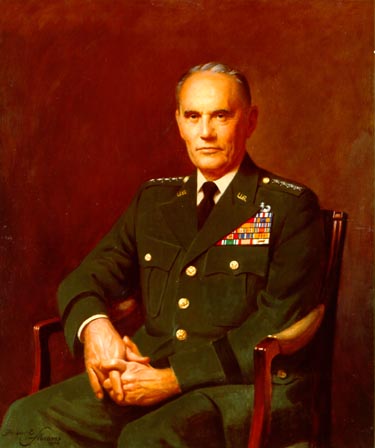
Bruce Palmer, Jr., was born in Austin, Texas, on 13 April 1913; graduated from the United States Military Academy in 1936; was commissioned a second lieutenant and served with the 8th Cavalry at Fort Bliss, 1936–1939; married Kay Sibert, 1936; was promoted to first lieutenant, June 1939, and served as regimental adjutant, June–September 1939; graduated from the Cavalry School at Fort Riley, 1940; was a troop and squadron commander of the 6th Cavalry (Mechanized), 1940–1942; was promoted to temporary ranks of captain, October 1940, and major, February 1942; served in the Operations Division of the War Department General Staff, 1942–1943; was promoted to temporary lieutenant colonel, February 1943; was chief of staff of the 6th Infantry Division in Southwest Pacific operations in World War II, 1944–1945; was promoted to temporary colonel, January 1945, and permanent captain, June 1946, and major, July 1948; commanded the 63d Infantry in the Korean occupation, 1945–1946; was chief of plans and operations of the First Army, 1947–1949; was instructor of tactics and then director of instruction at the Infantry School, Fort Benning, 1949–1951; concurrently completed the basic airborne course; graduated from the Army War College, 1952; was secretary of the general staff and chief of the Plans Division, United States Army, Europe, 1952–1954; was promoted to permanent lieutenant colonel, July 1953; was commander of the 16th Infantry, 1954–1955; served on the faculty of the Army War College, 1955–1957; was deputy secretary of the General Staff and White House liaison officer, Office of the Chief of Staff, 1957–1959; was promoted to temporary brigadier general, August 1959; was deputy commandant of the Army War College, 1959–1961; was assistant division commander of the 82d Airborne Division at Fort Bragg, 1961–1962; was promoted to permanent colonel, June 1961, and temporary major general, May 1962; was chief of staff of the Eighth Army, Korea, 1962–1963; was assistant deputy chief of staff for plans and operations, 1963–1964, and deputy chief of staff for military operations, 1964–1965; was promoted to permanent brigadier general, February 1963, and temporary lieutenant general, July 1964; was commander of Task Force 120 and United States Land Forces, Dominican Republic, May 1965; was concurrently commander of United States Forces and Army Forces and deputy commander of the Inter-American Peace Force in operations in the Dominican Republic, May 1965–January 1966; was commander of the XVIII Airborne Corps, 1965–1967; was commander of the II Field Force, Vietnam, and deputy commander of the United States Army, Vietnam, 1967–1968; was promoted to temporary general, August 1968, and served as vice chief of staff of the United States Army, 1 August 1968–30 June 1972; was acting chief of staff of the United States Army 1 July–11 October 1972; provided managerial continuity at the top of the Army during the Westmoreland-Abrams interregnum, supervised the continuing drawdown of Army forces from Vietnam and related Army-wide readjustments, and prepared major revisions in Army organizational structure; resumed duties as vice chief of staff; was commander in chief of the United States Readiness Command, 1973–1974; retired from the Army, September 1974.
The Artist
Herbert Elmer Abrams (1921–), who also painted Generals William C. Westmoreland and Creighton W. Abrams, Jr., has given television lectures on painting, has been interviewed on radio, and has written in American Artist on the work of his distinguished teacher, Frank Vincent DuMond. A 1975 film, A Different Light, on Abrams and his art won the Keith L. Ware Annual Award for Excellence in Newspapers, Magazines, Radio, and Television, and the Department of Defense’s Thomas Jefferson Award for outstanding achievement in promoting a fuller understanding of the mission of the armed forces.
Bruce Palmer, Jr.
By Herbert Elmer Abrams
Oil on canvas, 42" x 36", 1975
[142]
